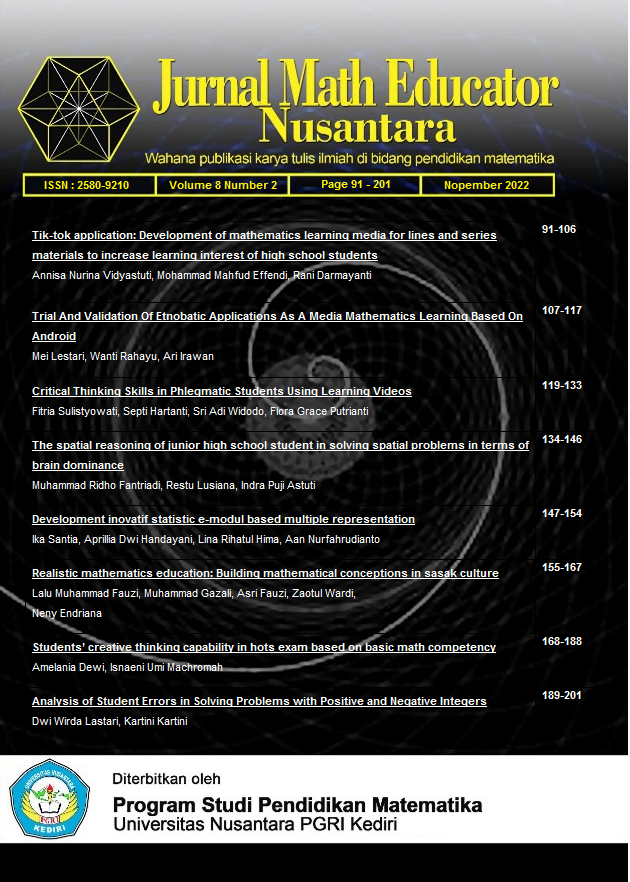Development inovatif statistic e-modul based multiple representation
DOI:
https://doi.org/10.29407/jmen.v8i2.18664Keywords:
statistics e-module, innovative, multiple representationAbstract
Mathematical thinking in problem-solving is an important goal of learning mathematics. The ability to use various ways of presenting mathematical concepts (multi-representation) is an important aspect of mathematical thinking. In its implementation, students experience problem-solving failures because of difficulties in making changes from one representation to another. This fact can be seen from the initial observations in statistics class, which showed that out of 37 students, only 12 students were successful in solving statistical problems because they could change verbal and graphic representations to symbolic ones correctly. Meanwhile, 17 out of 25 students failed because they did not understand the problems displayed in graphic form. To overcome this problem, statistical module development research has been carried out by applying the SPSS practice video barcode innovation. The development method uses a modified 4-D model, namely define, design, and develop. Modifications are carried out by eliminating the dissemination stage due to limited time and research costs. Data collection techniques in this study used a questionnaire. The data obtained are qualitative and quantitative. The results showed that the module developed was included in the very feasible criteria, in terms of content feasibility at 85.78%, language feasibility at 88.61%, presentation feasibility at 84.82%, and graphic feasibility at 84.72%. The results of the trial were limited to 37 students who received a positive response of 85,63% so the statistics module was suitable for use as teaching materials.
References
Anugrahana, A. (2019). Pengembangan modul sempoa sebagai alternatif dalam mata kuliah inovatif matematika. Jurnal Cendekia: Jurnal Pendidikan Matematika, 3(2), 462-470.
Biber, A. C. (2014). Mathematics Teacher candidate's Still of Using Multiple Representation for Division of fraction. Educational Research and Reviews, 9(8), 237-244
Depdiknas. (2008). Teknik Penyusunan Modul. Jakarta: Departemen Pendidikan Nasional. Depdiknas, 2013. Kurikulum 2013. Jakarta: Pusat Kurikulum, Balitbangdiknas, Jakarta.
Herawati, N. S., & Muhtadi, A. (2018). Pengembangan modul elektronik (e-modul) interaktif pada mata pelajaran Kimia kelas XI SMA. Jurnal inovasi teknologi pendidikan, 5(2), 180-191.
Khabibah, S. (2006). Pengembangan Model Pembelajaran Matematika Dengan Soal Terbuka Untuk Meningkatkan Kreativitas Siswa Sekolah Dasar. Disertasi yang tidak diterbitkan. Surabaya :Perpustakaan Pacasarjana Unesa.
Mahmud, M. R., & Pratiwi, I. M. (2019). Literasi numerasi siswa dalam pemecahan masalah tidak terstruktur. Kalamatika: Jurnal Pendidikan Matematika, 4(1), 69-88.
National Council of Teachers of Mathematics. 2003.Curriculum and Evaluation Standards for School Mathematics, Reston, Virginia: NCTM.
OECD. (2017). PISA for Development Assessment and Analytical Framework: Reading, Mathematics and Science (Preliminar). OECD Publishing.
Sadiman, A. (2012). Media Pendidikan. Jakarta: Rajagrafindo Persada
Santia, I., Fiantika, F. R., & Jatmiko, J. (2017). Pengembangan BKS berbasis MCK (mathematical content knowledge) sebagai upaya meningkatkan literasi matematika siswa SMP. Jurnal Math Educator Nusantara: Wahana Publikasi Karya Tulis Ilmiah Di Bidang Pendidikan Matematika, 3(2), 127-134.
Santia, I. (2018). Analisis Kemampuan Literasi Matematis Siswa SMP Berdasarkan Motivasi Belajar Siswa. JIPMat, 3(2).
Santia, I., Purwanto, Sutawidjadja, A., Sudirman, & Subanji. (2019). Exploring Mathematical Representations in Solving Ill-Structured Problems: The Case of Quadratic Function. Journal on Mathematics Education, 10(3), 365-378.
Santia, I., Purwanto, Sudirman, Subanji, & Sutawidjadja, A. (2021). Characteristics of Prospective Student Teacher’s Representation in Solving Ill-Well Algebraic Problems. In Journal of Physics: Conference Series (Vol. 1779, No. 1, p. 012001). IOP Publishing.
Sugiyono. (2010). Memahamai Penelitian Kualitatif. Bandung: CV.ALFABETA
Sutrisno, E. (2019). Pengembangan E-Modul Matematika Interaktif Menggunakan Visual Studio (Doctoral dissertation, UIN Raden Intan Lampung).
Thiagarajan, S., Semmel, D.S., & Semmel, M.I. (1974). Instructional Development for Training Teachers of Exceptional Children. Bloomington: Indiana University.
Downloads
Published
Issue
Section
License
Authors who publish with this journal agree to the following terms:
- Copyright on any article is retained by the author(s).
- The author grants the journal, the right of first publication with the work simultaneously licensed under a Creative Commons Attribution License that allows others to share the work with an acknowledgment of the work’s authorship and initial publication in this journal.
- Authors are able to enter into separate, additional contractual arrangements for the non-exclusive distribution of the journal’s published version of the work (e.g., post it to an institutional repository or publish it in a book), with an acknowledgment of its initial publication in this journal.
- Authors are permitted and encouraged to post their work online (e.g., in institutional repositories or on their website) prior to and during the submission process, as it can lead to productive exchanges, as well as earlier and greater citation of published work.
- The article and any associated published material is distributed under the Creative Commons Attribution-ShareAlike 4.0 International License
















